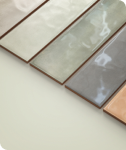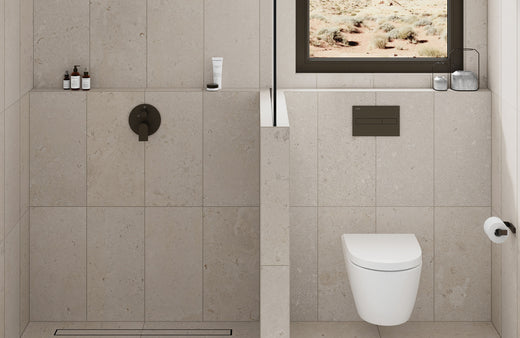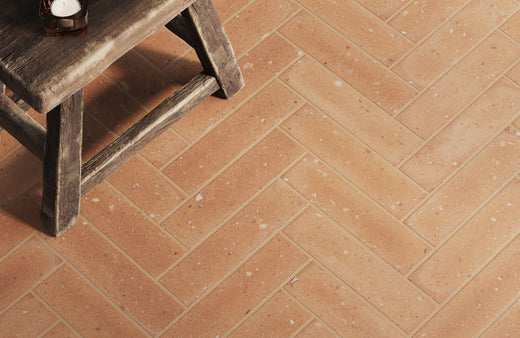We all have that bathroom—the one that’s perfectly functional but feels tight and uninspiring. While some may have the option to expand the space, the majority of us need practical, achievable solutions for how to make a small bathroom look bigger without major renovations
Making a small bathroom look bigger can seem like a daunting task, but with the right design choices, you can transform a cramped space into one that feels open and inviting. Simple yet effective strategies, from color schemes to tile selections, can create the illusion of more room, helping even the tiniest bathrooms feel spacious and comfortable.
By implementing a few key design elements and tapping into creative strategies—particularly with bathroom tiles—you can make a transformative impact on your space. Whether you are planning a DIY renovation or consulting with professionals, these practical tile solutions and tips will help you create a space that looks and feels more expensive than it is.
Tip #1: Maximize Tile Impact for a Seamless Finish
Bathroom tiles have been a staple for centuries, and for good reason—they’re perfect for wet areas, offer a wide range of design possibilities, and provide a durable, non-porous surface that helps prevent moisture issues like mold and mildew. In small bathrooms, the choice of tiles plays a crucial role in determining how spacious the area feels.
To assist in making this decision, many homeowners now use the Augmented Reality (AR) tool that allows you to visualize how different tile styles, colors, and textures will look in your bathroom. Previewing your tile choices in real time can give you the confidence to make the right decision without committing to something permanent.
Why Larger Tiles Work Better in Small Bathrooms
Small, intricate tile patterns—like mosaics or dark-colored designs—introduce more grout lines, which can make a bathroom feel cramped. Larger, solid-colored tiles are a better choice as they reduce grout lines, minimizing visual clutter and creating a smoother, more cohesive look. This allows the eye to move freely, making the room feel larger and more open, much like the effect of using light-colored walls.
Porcelain tiles are a more durable option than ceramic, especially in high-moisture areas like bathrooms. While ceramic tiles can work in some cases, porcelain offers better water resistance and longevity.
Remember: Always consult a professional when choosing tile materials. The suitability of ceramic or porcelain tiles may vary depending on the bathroom’s moisture levels and usage.
Light Colors and Seamless Tile Designs
The design principles that apply to paint also work with tiles. Lighter hues can visually expand a small bathroom, creating an airy, spacious feel. For example, the Leona 24x24 Matte Porcelain Tile in Calacatta offers a perfect balance of soft tones that brighten the space.
Large-format porcelain tiles in these shades reflect more light, enhancing the room’s brightness and openness. For a cohesive look that adds warmth and functionality, Aniston 12x24 Matte Porcelain Tile in Calacatta Antico is an excellent choice, offering a seamless and stylish design for a small bathroom.
Tile Height and Continuity
One of the simplest ways to maximize a small bathroom’s size is by using tiles creatively in terms of height and continuity. By extending tiles all the way up to the ceiling or around windows, rather than stopping short and adding molding, you eliminate visual breaks that could shrink the room. Tiles can also be used seamlessly between the floor and the walls, establishing a continuous line that creates the illusion of a larger space.
For a touch of elegance, consider the Blair 24x48 Matte Porcelain Tile in Oniciata Beige. Imagine pairing this with built-in shower cubby holes for recessed nooks, also tiled, to create storage solutions that don’t clutter up your bathroom with additional shelves or caddies.
Tip #2: Optimize Your Shower Space
If your bathroom features a three-quarter bath with only a shower, there are numerous enclosure options that can help ease the cramped feeling—both physically and visually. For instance, quadrant shower enclosures with inward-swinging doors fit snugly in small spaces, making them ideal for tiny bathrooms. Similarly, sliding shower doors are another practical option because they don't require extra space to open.
Combine the Tub and Shower for Multi-Purpose Use
For those who need both a tub and shower, a bathtub-shower combination is an effective space-saving strategy. Enhancing the area with large bathroom tiles, particularly porcelain bathroom tiles, elevates the design and makes the area look bigger. Adding a striking feature to the shower wall, such as a bold color or accent tile, further emphasizes the room’s design. Clear glass shower doors are highly recommended because they allow the eye to travel through the space uninterrupted, creating a sense of openness.
For example, as seen in the photo above, modern bathtub-shower combinations designed specifically for small bathrooms are compact without sacrificing comfort. Pair these with sleek, minimalistic designs plus bathroom tiles that blend seamlessly into the overall space and you’ll create a cohesive look that maximizes the room's potential.
Tip #3: Add Accents and Mirrors to Expand the Room
Accents and mirrors can be game-changers in a small bathroom, not just for functionality but for the way they amplify light and reflect the surrounding space, making the room feel more open.
Accent Walls for a Pop of Color
If you want to make a bold statement, an accent wall with bathroom tiles is an ideal option. A dramatic, yet tasteful tile choice can add depth and character without overwhelming the space. Rich colors or textured porcelain tiles, for instance, can create a striking look that complements neutral tones and enhances the room's openness. However, remember to focus on a single wall—free of doors, windows, or mirrors—to keep the design clean and uninterrupted. This allows the accent tile to stand out, visually enlarging the space while injecting personality into the bathroom.
Seamless Transitions and Natural Light
If you want to stick with a cohesive and open look in your bathroom, transitions between different areas should be as seamless as possible. Using matching tiles on both the walls and floors helps establish an uninterrupted visual flow, allowing the eye to move freely and making the room feel larger. Natural light also plays a key role in enhancing this effect. A skylight or well-placed window can flood the space with light, adding to the feeling of openness. For privacy, consider options like stained glass or glass blocks, which allow light to filter in without compromising privacy.
Although accents are a great way of personalizing your space, bold, intricate tile patterns and high-contrast colors can often make small spaces feel cluttered or cramped. Instead, opt for smooth, one-tone porcelain tiles that visually extend the walls and floors, creating the illusion of a larger area. For a touch of creativity, tiles with a subtle texture or a slight sheen can reflect light and make the room feel brighter. The Aniston 24x48 Matte Porcelain Tile in Carrara Bianco for example, adds a sophisticated pop of color while maintaining a spacious and airy feel.
Use Large Mirrors to Maximize Reflection
While it may seem logical to use small mirrors in a compact bathroom, larger mirrors can have a much bigger impact. Consider installing a large, wall-mounted mirror or even covering an entire wall section with mirrors. This instantly doubles the room's perceived size, even though the dimensions haven’t changed.
For an added effect, place a mirror opposite a window to enhance natural light reflection, further increasing the sense of depth. A mirror reflecting an adjoining room can also create the illusion of more space. Pairing these mirrors with light-colored porcelain tiles, such as the Giada 12x24 Matte Porcelain Tile in Calacatta Gold, adds even more shine and depth, amplifying the open and airy feel of the bathroom.
Tip #4: Maximize Your Storage with Wall-Mounted Solutions
Maximizing storage space in a small bathroom can be challenging, but wall-mounted solutions offer a smart and stylish way to keep things organized while enhancing the overall design. By using vertical space, wall-mounted shelves, cabinets, and hooks free up floor space, creating a more open, uncluttered feel.
Consider recessed medicine cabinets that sit flush with the wall, blending seamlessly into the room while providing essential storage. This eliminates the bulk of traditional cabinets and pairs beautifully with porcelain bathroom tiles, maintaining clean lines that contribute to an open feel.
Vertical storage options, such as sturdy hooks or baskets, can also be installed on walls or ceilings to store toiletries and towels, keeping the floor space clear and ensuring a tidier, more spacious look.
When space is at a premium, smart storage solutions are ideal for freeing up floor space and making the bathroom feel larger.
Tip #5: Wall-Mount the Sink and Toilet for Extra Floor Space
If you haven't explored the option of wall-mounted sinks and toilets, it’s time to consider their potential. These fixtures create an ultra-clean, minimalist look because they eliminate the need for a pedestal or bulky cabinet to conceal plumbing. While this upgrade may require an initial investment, it’s one that many find worthwhile, as it frees up valuable floor space by removing the traditional bases of toilets and sinks.
Wall-mounted models attach directly to the wall, creating a sleek, "floating" effect that contributes to a more open and spacious feel. To enhance this effect, consider using light-colored tiles like the Callum 24x24 Matte Porcelain Tile in Gravel on the wall behind these fixtures. The combination of floating fixtures and light-colored tiles works together to further open up the space and maintain a clean, airy atmosphere.
More Tips and Tricks
There are additional ways to make a small bathroom look bigger:
Switch out bulky shelving
Replace wide shelving units with slim, space-efficient designs paired with matching bathroom tiles for continuity.
Utilize space above the toilet
The wall space behind and above the toilet is often overlooked. Wall-mounted shelves or cabinets here can provide extra storage while incorporating bathroom tiles to match the design.
Play with lighting
Light fixtures combined with reflective bathroom tiles, such as polished porcelain tiles, can highlight key areas and make the space feel bigger.
Ready to Transform Your Small Bathroom?
Whenever you're ready to make changes to your bathroom—whether it’s an upgrade, repair, or a full redesign—consider requesting our high-quality 4" x 4" samples, which accurately reflect the color and finish of all tile sizes within each collection.
In addition to our bathroom tiles, we also offer professional design services to help bring your vision to life. This ensures you not only receive a true representation of our tiles but also expert guidance to create a truly distinctive and appealing bathroom environment. Exploring these samples and design options can be the final step in confirming that your selection exceeds your expectations.
Frequently Asked Questions (FAQ)
If you're among the many homeowners seeking more clarity on the best types of bathroom tiles, how to mix styles, and how to use them effectively in small spaces, you're not alone. Here, we address some of the most frequently asked questions to help you make informed decisions about your bathroom renovation.
1. What type of bathroom tiles are best for small spaces?
For small bathrooms, large, light-colored porcelain tiles are ideal. These tiles reduce grout lines, create a seamless look, and reflect more light, helping the space feel bigger and more open.
Remember: When choosing tiles for shower floors, ensure they have sufficient slip resistance for safety. While large, smooth porcelain tiles work well for walls and open floors, smaller tiles or those with textured surfaces are recommended for shower floors to prevent slipping, especially in wet conditions. Always consult with a professional to ensure the tiles meet safety standards for bathroom use.
2. Can I mix different tile styles in a small bathroom?
Yes, but it's important to keep it balanced. Use neutral, light-colored tiles for most of the room, and consider a feature or accent wall with a bolder tile design. Mixing too many tile styles can create visual clutter in a small space.
3. Are there specific paint colors that work well with bathroom tiles?
Light colors like white, cream, soft gray, and pastel shades work best with bathroom tiles. These colors reflect natural and artificial light, making the room appear more spacious. Pairing these shades with matching light-colored tiles enhances the effect.
4. What’s the best way to incorporate tile accents without making the space feel cluttered?
Focus on a single feature, such as a shower wall or backsplash, for accent tiles. Keep the rest of the bathroom simple with neutral colors and larger tiles to avoid visual clutter. This approach draws attention to the accent without compromising the feeling of space.
5. What’s the difference between ceramic and porcelain tiles?
Ceramic tiles are generally less dense and slightly more porous than porcelain tiles, making them more affordable. Porcelain tiles are denser, more water-resistant, and often considered more durable, making them ideal for high-moisture areas like bathrooms. Both are excellent choices depending on your needs and budget.












